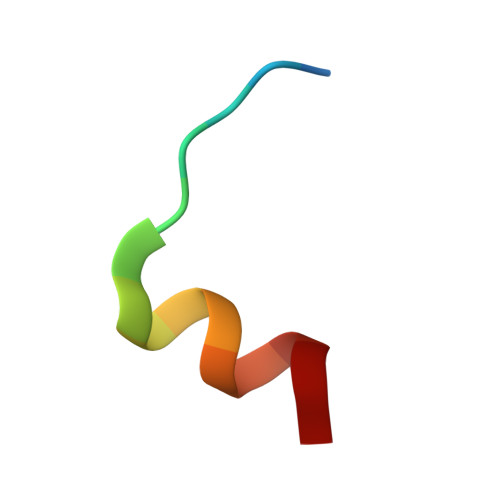Switched or Not?: the Structure of Unphosphorylated CheY Bound to the N Terminus of FliM.
Dyer, C.M., Dahlquist, F.W.(2006) J Bacteriol 188: 7354-7363
- PubMed: 17050923
- DOI: https://doi.org/10.1128/JB.00637-06
- Primary Citation of Related Structures:
2B1J - PubMed Abstract:
Phosphorylation of Escherichia coli CheY increases its affinity for its target, FliM, 20-fold. The interaction between BeF(3)(-)-CheY, a phosphorylated CheY (CheY approximately P) analog, and the FliM sequence that it binds has been described previously in molecular detail. Although the conformation that unphosphorylated CheY adopts in complex with FliM was unknown, some evidence suggested that it is similar to that of CheY approximately P. To resolve the issue, we have solved the crystallographic structure of unphosphorylated, magnesium(II)-bound CheY in complex with a synthetic peptide corresponding to the target region of FliM (the 16 N-terminal residues of FliM [FliM(16)]). While the peptide conformation and binding site are similar to those of the BeF(3)(-)-CheY-FliM(16) complex, the inactive CheY conformation is largely retained in the unphosphorylated Mg(2+)-CheY-FliM(16) complex. Communication between the target binding site and the phosphorylation site, observed previously in biochemical experiments, is enabled by a network of conserved side chain interactions that partially mimic those observed in BeF(3)(-)-activated CheY. This structure makes clear the active role that the beta4-alpha4 loop plays in the Tyr(87)-Tyr(106) coupling mechanism that enables allosteric communication between the phosphorylation site and the target binding surface. Additionally, this structure provides a high-resolution view of an intermediate conformation of a response regulator protein, which had been generally assumed to be two state.
Organizational Affiliation:
Department of Chemistry and Biochemistry, University of California at Santa Barbara, 93106, USA.
















